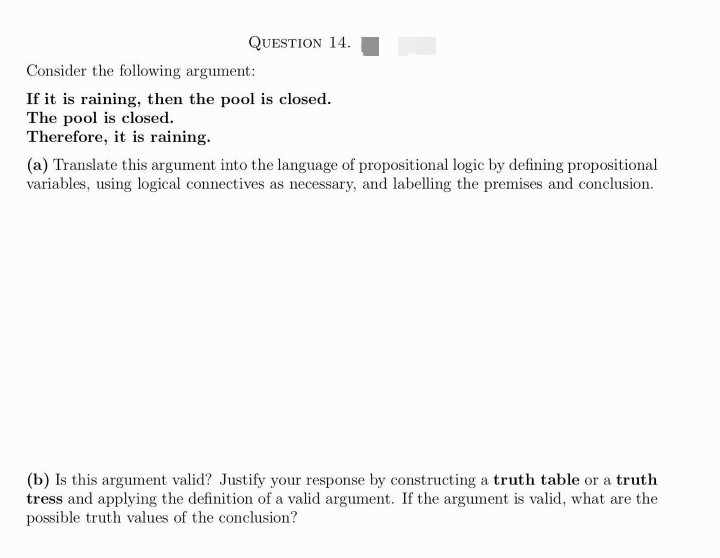QUESTION 14. Consider the following argument: If it is raining, then the pool is closed. The pool is closed. Therefore, it is raining. (a) Translate this argument into the language of propositional logic by defining propositional variables, using logical connectives as necessary, and labelling the premises and conclusion.
QUESTION 14. Consider the following argument: If it is raining, then the pool is closed. The pool is closed. Therefore, it is raining. (a) Translate this argument into the language of propositional logic by defining propositional variables, using logical connectives as necessary, and labelling the premises and conclusion.
Algebra: Structure And Method, Book 1
(REV)00th Edition
ISBN:9780395977224
Author:Richard G. Brown, Mary P. Dolciani, Robert H. Sorgenfrey, William L. Cole
Publisher:Richard G. Brown, Mary P. Dolciani, Robert H. Sorgenfrey, William L. Cole
Chapter10: Inequalities
Section10.6: Absolute Value Of Product In Open Sentences
Problem 19WE
Related questions
Question
Q14 solve both parts plz
I need correct and perfect soloution plz take ur time and solve perfectly plz and show neat and clean handwriting plz

Transcribed Image Text:QUESTION 14.
Consider the following argument:
If it is raining, then the pool is closed.
The pool is closed.
Therefore, it is raining.
(a) Translate this argument into the language of propositional logic by defining propositional
variables, using logical connectives as necessary, and labelling the premises and conclusion.
(b) Is this argument valid? Justify your response by constructing a truth table or a truth
tress and applying the definition of a valid argument. If the argument is valid, what are the
possible truth values of the conclusion?

Transcribed Image Text:Long-Answer Questions
Important: In all proofs, for each step, you must clearly indicate whether you are assuming
something, or whether what you wrote is something that follows from a definition or a
previous step of your proof. If any variables appear in your proof, make sure you clearly
indicate what they represent.
Expert Solution
This question has been solved!
Explore an expertly crafted, step-by-step solution for a thorough understanding of key concepts.
Step by step
Solved in 2 steps with 2 images

Recommended textbooks for you

Algebra: Structure And Method, Book 1
Algebra
ISBN:
9780395977224
Author:
Richard G. Brown, Mary P. Dolciani, Robert H. Sorgenfrey, William L. Cole
Publisher:
McDougal Littell

Elementary Geometry for College Students
Geometry
ISBN:
9781285195698
Author:
Daniel C. Alexander, Geralyn M. Koeberlein
Publisher:
Cengage Learning

Algebra & Trigonometry with Analytic Geometry
Algebra
ISBN:
9781133382119
Author:
Swokowski
Publisher:
Cengage

Algebra: Structure And Method, Book 1
Algebra
ISBN:
9780395977224
Author:
Richard G. Brown, Mary P. Dolciani, Robert H. Sorgenfrey, William L. Cole
Publisher:
McDougal Littell

Elementary Geometry for College Students
Geometry
ISBN:
9781285195698
Author:
Daniel C. Alexander, Geralyn M. Koeberlein
Publisher:
Cengage Learning

Algebra & Trigonometry with Analytic Geometry
Algebra
ISBN:
9781133382119
Author:
Swokowski
Publisher:
Cengage


Elementary Geometry For College Students, 7e
Geometry
ISBN:
9781337614085
Author:
Alexander, Daniel C.; Koeberlein, Geralyn M.
Publisher:
Cengage,

Algebra and Trigonometry (MindTap Course List)
Algebra
ISBN:
9781305071742
Author:
James Stewart, Lothar Redlin, Saleem Watson
Publisher:
Cengage Learning